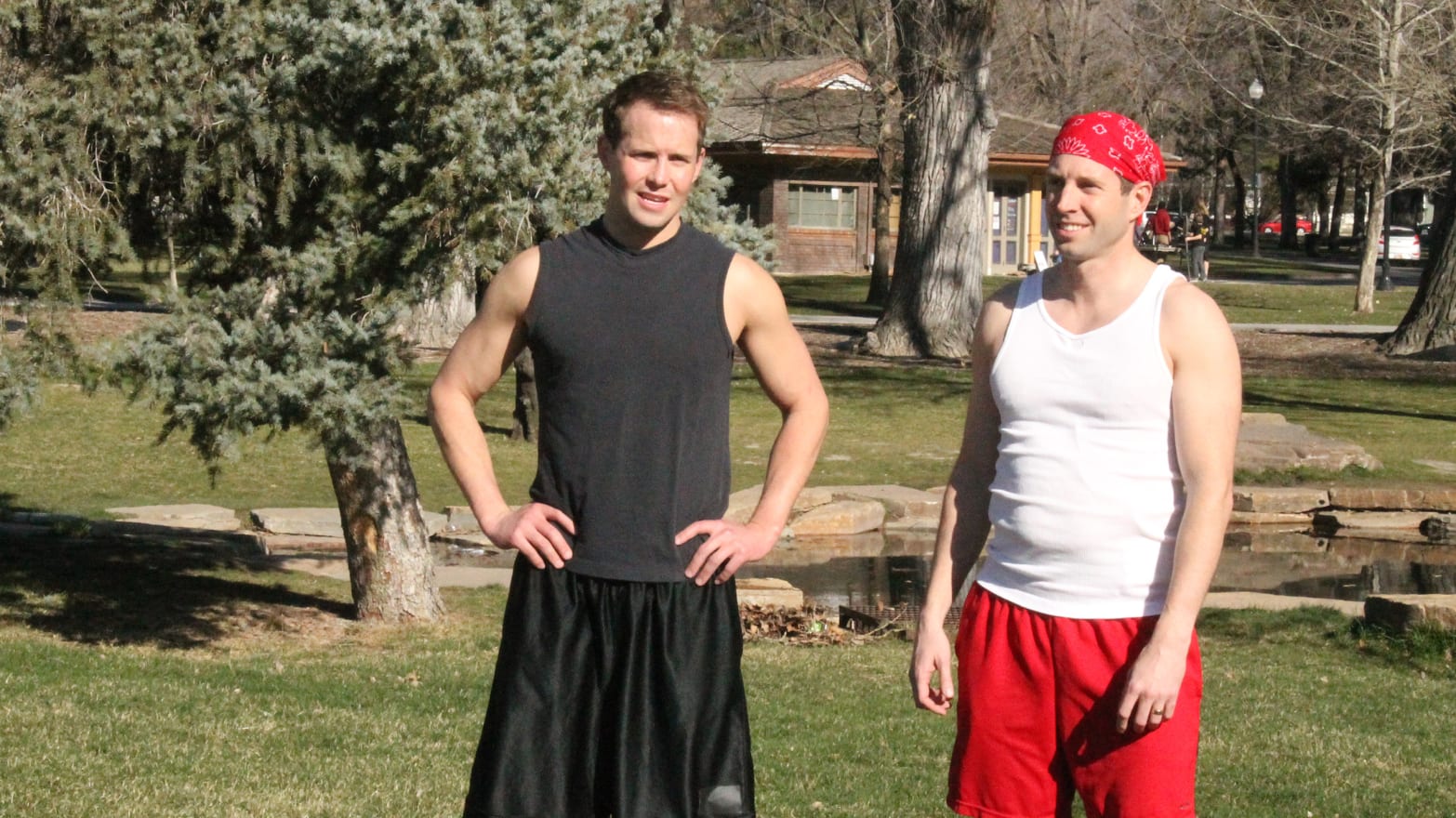TLC’s reality programming has always boasted an impressive pantheon of gay men: the ever dapper Clinton Kelly on What Not to Wear, former Miss Gay America Randy Fenoli on Say Yes to the Dress, the illustrious Vern Yip on Trading Spaces. On January 11, we can add to that number the men on TLC’s new reality special My Husband’s Not Gay, which showcases Mormon men who are open about their attraction to men even as they date and sometimes marry women.
The trailer for the special depicts clean-cut Mormon men ice-skating with their wives and girlfriends as their individual voiceovers slowly reveal a shared secret.
“I’m attracted to my wife for sure,” says one, “And I’m definitely attracted to men, too.”
“I want to marry a woman but I don’t know how to work out these feelings,” adds another.
After the release of the trailer for the special last week, TLC received a requisite and perhaps well-deserved tongue-lashing. Mary Elizabeth Williams of Salon labels the show a “crass stunt” on a “bottom-feeding vortex of sadness network.” Isha Aran at Jezebel worries that the show “glorif[ies] the way religion can constrain people.” ThinkProgress calls the premise “uncomfortable and vaguely sad.” Across the board, My Husband’s Not Gay has been cited as a new low for both the network and the stubbornly homophobic Mormon religion.
There’s no denying that My Husband’s Not Gay exploits people in precarious positions or that the Church of Jesus Christ of Latter-day Saints—which reaffirmed its opposition to same-sex marriage this October—is anti-gay. But if we dig deeper, we might also see the show as a painful portrait of a religion stuck at a crossroads with respect to its official policy on homosexuality. Although the Mormon Church, as it is commonly known, has long opposed homosexuality—most notably playing an influential role in California’s since-overturned 2008 ban on same-sex marriage—its official stance toward its own gay members has softened over the years. But the plight of the men on My Husband’s Not Gay demonstrates that Mormonism is not changing quickly enough to prevent another generation of sham marriages.
The Mormon Church didn’t always toe a hard line on homosexuality. As American historian D. Michael Quinn observes, men in 19th century America were much more lenient about casual forms of homosocial intimacy and Mormons were no exception. In fact, Joseph Smith, the founder of Mormonism, once wrote that “it is pleasing for friends to lie down together, locked in the arms of love, to sleep and wake in each other’s embrace and renew their conversation.” How strange, then, that the Mormon Church’s current missionary handbook specifies that missionaries should “always sleep in the same room as your companion, but not in the same bed.”
What changed between then and today? Although homosexuality has technically been verboten since the start of the religion, Quinn presents evidence that it wasn’t until the McCarthy era that Mormon leaders began to crack down on homosexuality. Under the leadership of Spencer W. Kimball, then an apostle in the church’s ranks, Mormon officials began to treat “unrepentant” homosexuality as an excommunicable offense. It was also during Kimball’s tenure that researchers at the church-owned Brigham Young University (BYU) reportedly began conducting electroshock aversion therapy on gay male students. At least one doctoral thesis, Quinn notes, was produced out of this therapy program and the 1996 independent documentary legacies interviews several men who allege that they were inducted into it. Throughout Kimball’s leadership—which stretched until his death in 1985—Church leaders were adamant that homosexuality was not inborn and that heterosexual marriage was its chief cure.
For Randy, a 50-year-old ex-Mormon gay man, this cure was a particularly bitter pill to swallow. In an e-mail to The Daily Beast, he writes, “The pain, sadness, and damage is still a part of my life even though I got out with only one child and two years married. It’s been a lifetime project to heal and build a life for myself outside.”
But the modern Mormon Church has taken several steps back from Kimball’s fire and brimstone attitude. In fact, the central premise of My Husband’s Not Gay—that gay Mormon men should date and marry women while still feeling attraction to men—has technically been against church counsel since 1992, when a new handbook entitled Understanding and Helping Those Who Have Homosexual Problems instructed Mormon leaders that “marriage should not be viewed as a way to resolve homosexual problems.” The handbook cited the deleterious effects of this policy on both gay men and “the lives of others,” referring, of course, to the women who spent years locked in marriages with them. Gay church members were also told to remain celibate in order to avoid church discipline and this requirement has been official Mormon policy ever since.
On this point, Randy wrote: “‘We will accept you if you are celibate for life’ seems to be the new message but this is not a workable answer, it’s a hopeless answer.”
But the church’s current handbook for gay members, God Loveth His Children, certainly tries hard to make it seem like a hopeful course of action. This pamphlet takes an even gentler tone, referring to “same-gender attraction” as a “challenge” that can be dealt with by remaining celibate and “fill[ing] your spiritual garden with good seed.” Perhaps filling something up with seed is not the best metaphor to use for gay men who want to suppress their perfectly natural urges, but that’s neither here nor there. The handbook also dodges the question of whether or not homosexuality is inborn. In a 2009 interview, Church apostle Dallin H. Oaks held that the Church “does not have a position” on that point. But Oaks also leaves open the possibility of marriage in a disclaimer-ridden run-on sentence:
“On the other hand, persons who have cleansed themselves of any transgression and who have shown their ability to deal with these feelings or inclinations and put them in the background, and feel a great attraction for a daughter of God and therefore desire to enter marriage and have children and enjoy the blessings of eternity—that’s a situation when marriage would be appropriate.”
And it’s at precisely this moment in Mormon Church history that a show like My Husband’s Not Gay enters the scene. The men that TLC will showcase in January are caught in a religion that simultaneously tells them that God loves them despite their “challenge” while also refusing to shut the door completely on the tantalizing possibility of full cultural acceptance within the faith.
From the outside, then, we might shame the men of My Husband’s Not Gay for not accepting who they are but within the context of the Mormon faith, we can hardly expect them to. The American Psychological Association may have closed the book on conversion therapy in 2009 but many gay Mormons, led on by equivocating statements from leaders like Oaks, are still hoping that they can change and eventually marry. And even though the church officially stopped counseling gay men to marry women in the 1990s, Mormon culture now does the same work that Kimball’s old injunctions used to perform.
As Randy wrote, “I guess this speaks to the church not really having a place for gay people so getting married is still implicit.”
The women who date and marry gay Mormon men are likewise victims of a religion that tacitly encourages heterosexual marriage at almost any cost. If the women on My Husband’s Not Gay fare similarly to the previous generation of Mormon cross-orientation marriages studied by University of North Florida sociologist Richard Phillips, they are likely to feel “unattractive” as a result of their spouses’ disinterest. D. Michael Quinn adds that, in the past, Mormon women married to gay Mormon men experienced “a consistent pattern of despair and self-loathing at their inability to achieve reciprocal intimacy.”
“I get a little defensive when somebody calls my husband gay,” says one woman in the TLC trailer, with a defiance that seems to barely paper over a deeper sadness.
But the fact that the men of My Husband’s Not Gay refuse to label themselves as “gay” is just as worrying. Although the Mormon Church has superficially scaled back its stance on homosexuality since Spencer W. Kimball’s death, it at least used to acknowledge the existence of a population of people with a well-defined (if also maligned) sexual identity. Church leaders used to rail against “homosexuals” but, in a 1995 sermon, then-Mormon President Gordon B. Hinckley traded that descriptor for the following euphemistic mouthful: “those who struggle with feelings of affinity for the same gender.”
Across all contemporary Mormon rhetoric, Church leaders refuse to legitimize homosexuality by referring to it as a concrete thing. As Dallin H. Oaks said in the above-quoted 2009 interview: “I think it’s important for you to understand that homosexuality…is not a noun that describes a condition. It’s an adjective that describes feelings or behavior.” True to form, none of the men on My Husband’s Not Gay refer to themselves as gay, opting instead to claim “attraction” to men—a phrasing that conforms with the Church of Jesus Christ of Latter-day Saints’ official term for homosexuality: “same-sex attraction.”
It would definitely be wrong for TLC to encourage us to gawk at these men but their story is worth investigating nonetheless. As Randy notes, “Maybe there is a value in shining a light on this and asking the questions.” The Mormon Church may have traded electrodes for euphemism and excommunications for loving leaflets but in so doing, they have also created a culture in which members cannot even admit to themselves that they are who they are. My Husband’s Not Gay is not so much a straightforward indication that Mormonism is homophobic as it is a sign that Mormon homophobia has taken an even subtler and perhaps more pernicious turn.

